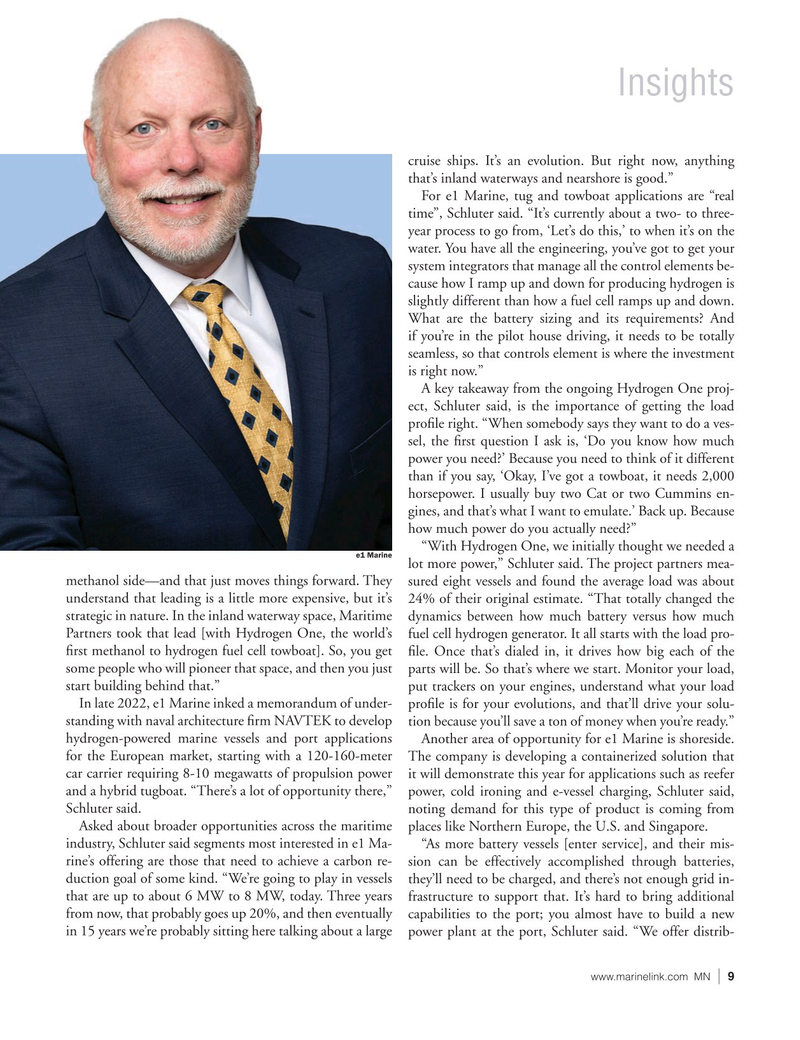
Page 9: of Marine News Magazine (February 2023)
Power & Propulsion
Read this page in Pdf, Flash or Html5 edition of February 2023 Marine News Magazine
Insights cruise ships. It’s an evolution. But right now, anything that’s inland waterways and nearshore is good.”
For e1 Marine, tug and towboat applications are “real time”, Schluter said. “It’s currently about a two- to three- year process to go from, ‘Let’s do this,’ to when it’s on the water. You have all the engineering, you’ve got to get your system integrators that manage all the control elements be- cause how I ramp up and down for producing hydrogen is slightly different than how a fuel cell ramps up and down.
What are the battery sizing and its requirements? And if you’re in the pilot house driving, it needs to be totally seamless, so that controls element is where the investment is right now.”
A key takeaway from the ongoing Hydrogen One proj- ect, Schluter said, is the importance of getting the load pro? le right. “When somebody says they want to do a ves- sel, the ? rst question I ask is, ‘Do you know how much power you need?’ Because you need to think of it different than if you say, ‘Okay, I’ve got a towboat, it needs 2,000 horsepower. I usually buy two Cat or two Cummins en- gines, and that’s what I want to emulate.’ Back up. Because how much power do you actually need?” “With Hydrogen One, we initially thought we needed a e1 Marine lot more power,” Schluter said. The project partners mea- methanol side—and that just moves things forward. They sured eight vessels and found the average load was about understand that leading is a little more expensive, but it’s 24% of their original estimate. “That totally changed the strategic in nature. In the inland waterway space, Maritime dynamics between how much battery versus how much
Partners took that lead [with Hydrogen One, the world’s fuel cell hydrogen generator. It all starts with the load pro- ? rst methanol to hydrogen fuel cell towboat]. So, you get ? le. Once that’s dialed in, it drives how big each of the some people who will pioneer that space, and then you just parts will be. So that’s where we start. Monitor your load, start building behind that.” put trackers on your engines, understand what your load
In late 2022, e1 Marine inked a memorandum of under- pro? le is for your evolutions, and that’ll drive your solu- standing with naval architecture ? rm NAVTEK to develop tion because you’ll save a ton of money when you’re ready.” hydrogen-powered marine vessels and port applications Another area of opportunity for e1 Marine is shoreside. for the European market, starting with a 120-160-meter The company is developing a containerized solution that car carrier requiring 8-10 megawatts of propulsion power it will demonstrate this year for applications such as reefer and a hybrid tugboat. “There’s a lot of opportunity there,” power, cold ironing and e-vessel charging, Schluter said,
Schluter said. noting demand for this type of product is coming from
Asked about broader opportunities across the maritime places like Northern Europe, the U.S. and Singapore.
industry, Schluter said segments most interested in e1 Ma- “As more battery vessels [enter service], and their mis- rine’s offering are those that need to achieve a carbon re- sion can be effectively accomplished through batteries, duction goal of some kind. “We’re going to play in vessels they’ll need to be charged, and there’s not enough grid in- that are up to about 6 MW to 8 MW, today. Three years frastructure to support that. It’s hard to bring additional from now, that probably goes up 20%, and then eventually capabilities to the port; you almost have to build a new in 15 years we’re probably sitting here talking about a large power plant at the port, Schluter said. “We offer distrib- www.marinelink.com MN 9|

 8
8

 10
10
